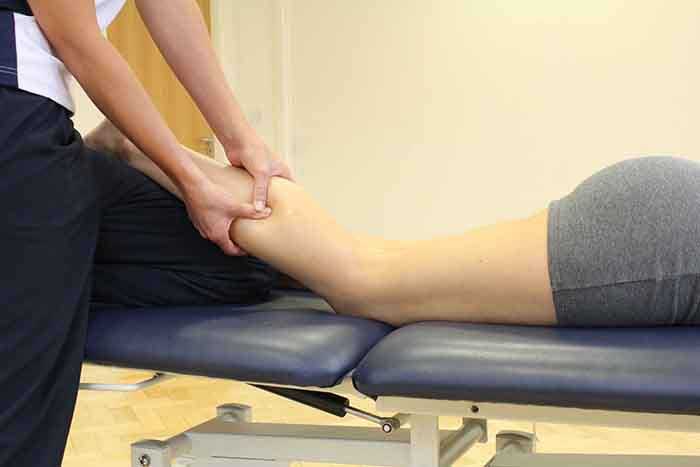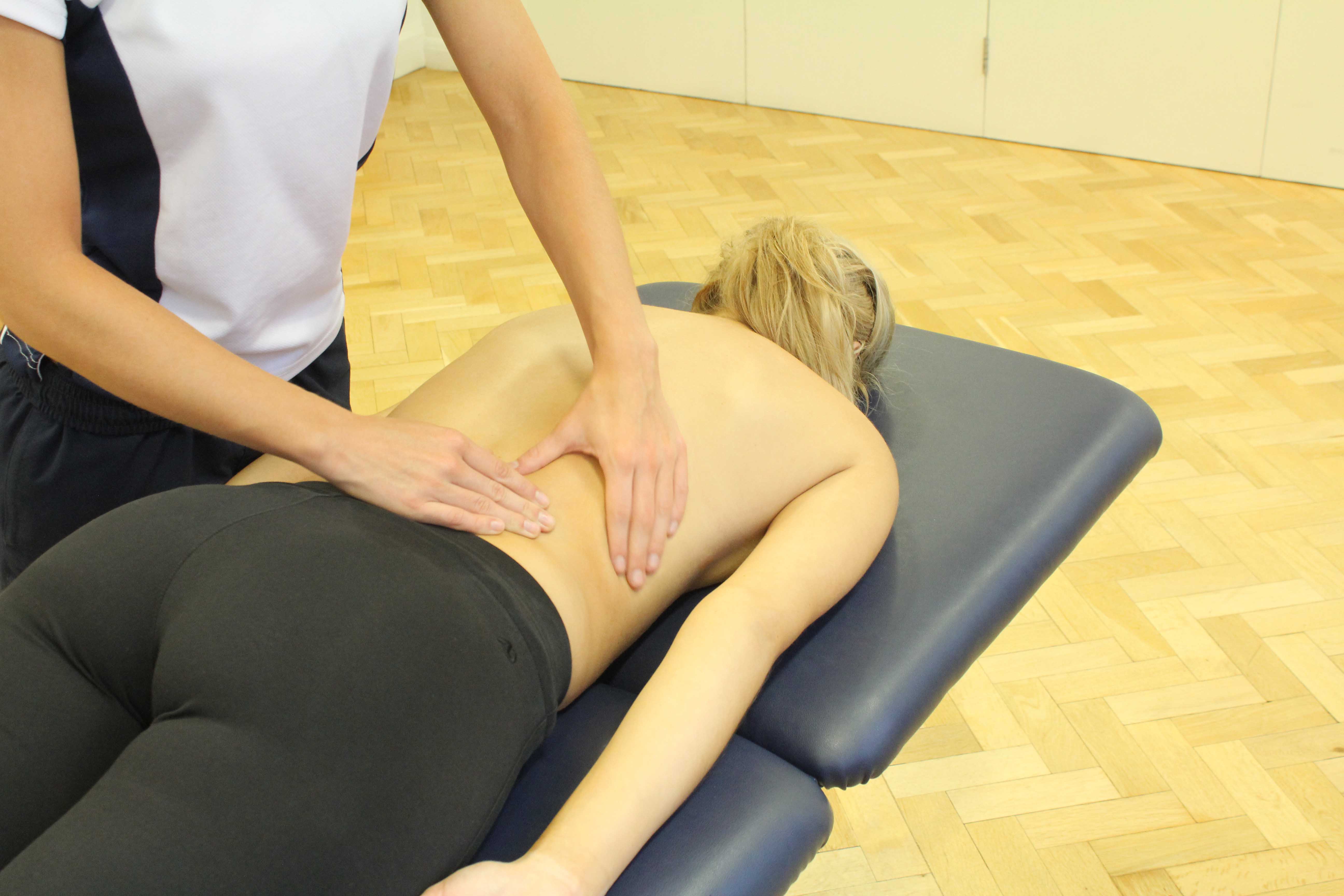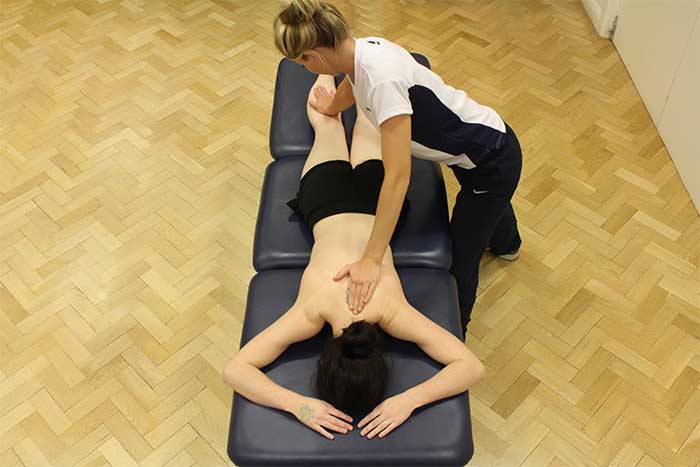A benefit of massage is improved recovery. Muscles can become damaged for a variety of reasons, most commonly by injury, surgery or over use. When muscles are damaged, the body's natural healing process is activated aiming to repair damaged tissues and fibres. Very often, healing can be slowed down due to a range of reasons, decreasing recovery. Common reasons healing is reduced include swelling, poor circulation, muscle fatigue and a build-up of tension. When recovery is decreased, pain can increase worsening the effects of injury. Our massage therapists at Physio.co.uk improve recovery through massage to help decrease pain, reduce tension and improve circulation.
What are the most appropriate types of massage to improve recovery?
There are a range of different types of massage that can help improve recovery. The most appropriate types of massage used include:
 Above: Soft tissue massage targeting vastus lateralis and illio-tibial band
Above: Soft tissue massage targeting vastus lateralis and illio-tibial bandThe most appropriate types of massage used to improve recovery include deep tissue massage. Therapeutic massage and remedial massage.
Deep tissue massage can help improve recovery. A deep tissue massage involves applying a firm pressure to the treatment area. A deep tissue massage is often used for the break-down of adhesions and collagen fibres as it aims to get deeper within the layers of tissue. Adhesions and collagen fibres are common reasons the recovery is reduced and pain is increased. Adhesions restrict movement causing muscle tightness and an increase in stress. Breaking down adhesions and collagen fibres through deep tissue massage improve recovery as an increase in movement is allowed and pain is reduced.

Therapeutic massage is often used to improve recovery. A therapeutic massage involves a series of long strokes ranging in pressure aiming to manipulate the body's muscle fibres and tissues creating a therapeutic effect. A therapeutic massage can improve recovery by increasing relaxation and reducing a build-up of tension. When recovery is decreased, this can also affect a person psychologically. A therapeutic massage stimulates the release of positive hormones endorphins, serotonin and dopamine which all promote relaxation, reduce pain and improved mood. Improving recovery through therapeutic massage can therefore benefit a person both physically and mentally.
Remedial massage is used to improve recovery. A remedial massage involves using a range of pressures depending on the treatment being provided and personal preference. A remedial massage manipulates both superficial and deeper layers of tissues, improving muscle condition and increasing relaxation. Improving muscle condition and increasing muscle relaxation decreases muscular fatigue and weakness and reduces tension. A remedial massage also helps to repair damaged muscles by reducing restriction, helping to reduce pain and further improve recovery.
What techniques are used to improve recovery?
There are a variety of massage techniques used to improve recovery. The techniques most often used during a massage include:
 Above: Soft Tissue Massage targeting lower latissimus dorsi and erector spinae
Above: Soft Tissue Massage targeting lower latissimus dorsi and erector spinaeThe most commonly used massage techniques to improve recovery include effleurage, kneading and trigger pointing.
Effleurage is often used to improve recovery. Effleurage is a gentle massage technique that varies in pressure. Flattened hands and fingers are used during effleurage, aiming to increase muscle temperature by stimulating an improvement in blood flow. A build-up of muscle tension within muscles can often slow down recovery. Tension can cause muscular knots that restrict movement and increase pain. By increasing temperature of muscles through effleurage, muscles are encouraged to relax and loosen, reducing tension. Reducing tension prevents muscular knots from forming and reduces pain. A decrease in tension and prevention of muscular knots both contribute to improving recovery.
Recovery can be improved using kneading. Kneading involves the pulling and squeezing of muscles around the treatment area. Kneading is often used to improve circulation and loosen tight muscles. Kneading creates friction between the skin and fingers which encourages an increase in blood flow to and around the treatment area. An increase in blood flow can improve recovery as nutrients and oxygen within the blood, essential for the repair and regrowth of damaged muscle fibres and tissues, are delivered to the injury site. Increasing the amount of oxygen and nutrients being delivered to the injury site can speed up the healing process and therefore recovery.
Trigger pointing is an effective technique used to improve recovery. Trigger points are located in the centre of a muscle fibre. At the site of a trigger point, there is an often increased amount of muscle tightness, tension and sometimes fatigue which all contribute to an increase in pain and decrease in recovery. Trigger pointing involves applying a frim pressure to the trigger points helping to break down and soften knots. When pressure is applied, blood flow is restricted causing an ischemic reaction. When pressure is released, an increase in blood flow occurs to help repair damaged muscle fibres, improving recovery.

When can a massage help to improve recovery?
A massage can help to improve recovery in many situations. The most common situations improved recovery through massage can help include:
Situations improved recovery through massage can help include acute pain. Post injury and post-surgery.
Acute pain can be helped when recovery is improved. When recovery is poor and slow, pain from the injury can stay and worsen. Pain can be a result of muscle tightness or tension caused by an injury or surgery. A massage aims to improve recovery to help reduce pain by relieving muscle tightness and tension. Muscle tightness and tension is relieved through an increase in tissue elasticity. An increase in tissue elasticity occurs as muscle temperature increases due to an increase in blood flow. When tissue elasticity increases the ability to stretch a muscle to its full length improves, as well as allowing the muscle to fully relax with no restriction. Increasing range of movement, allowing relaxation and reducing restriction by improving recovery all help to decrease pain.
Improving recovery through massage can help post injury. There are a variety of injuries a person can have, the most common being muscle pulls, strains or tears. When a muscle is damaged, inflammation can occur as well as an increase in pain. Collagen fibres also form to help repair the damaged muscle fibres. Collagen fibres restrict movement and pro long recovery. Improving recovery through massage helps to improve lymphatic flow, increase movement and decrease pain. Improving lymphatic flow removes metabolic wastes more efficiently. A more efficient lymphatic system helps to reduce inflammation. An increase in movement occurs when the collagen fibres are broken down, reducing restriction. Improving lymph flow and reducing restriction both decrease pain.
The effects of surgery can be reduced when recovery is improved. Surgery can leave damaging effects on a person. A common effect of surgery is a build-up of scar tissue. Scar tissue can be fibrous and restrict movement causing an increase in pain. During a massage, recovery is improved after surgery by the breakdown of scar tissue. Scar tissue is soften and broken down to help reduce restriction and increase range of movement. Reducing restriction helps to decrease pain.
What are the physiological effects of massage to improve recovery?
Various physiological effects occur during a massage that help improve recovery. The most common physiological effects that occur include:
The physiological effects that occur most frequently during a massage to improve recovery include the removal of waste products, increased oxygenation and the break down/realignment of collagen fibres.
The removal of waste products often occurs during a massage to help improve recovery. A build-up of waste products causes an increase in swelling. Swelling forms to protect the damaged area but can also increase pain and lengthen recovery time. Waste products also contribute to muscular fatigue and further increase recovery time. During a massage, the lymphatic system is stimulated. The lymphatic system aids in the removal of waste products through the lymph flow. Increasing lymph flow through massage removes waste products from the body more efficiently. A reduction in waste products promotes healthier, stronger muscles and decreases swelling and fatigue. Healthier muscles with decreased fatigue improve recovery.
A physiological effect of massage that helps improve recovery is increased oxygenation. Increased oxygenation occurs as an increase in capillaries form around a muscle. Oxygen is carried within the blood and is used as energy for healing and cellular exchange. When an increase in capillaries surrounding a muscle occurs, the amount of blood flow to the muscle also increases. An increase in blood flow increases the availability of oxygen. Increasing oxygen availability helps to improve recovery as an increase in energy for the healing process occurs. A lack of energy can slow down healing and therefore recovery. An increase in oxygenation also helps maintain the health and strength of a muscle whilst reducing muscular fatigue, further improving recovery.
The break down/realignment of collagen fibres can occur within a massage to improve recovery. Collagen fibres form cross links and are laid haphazardly across muscle fibres to help repair damage. The haphazard position collagen fibres are laid, reduces movement and increases restriction . A massage helps to break down collagen fibres through various techniques. When temperature of muscle fibres and tissues increase, the temperature of collagen fibres also increase. The various techniques are then used to break down and soften collagen fibres and the cross links formed. Breaking down the cross links allows the massage therapist to realign the collagen fibres in the same direction as the body's natural muscle fibres. Breaking down and realigning collagen fibres improves recovery as range of movement is increased, pain is reduced, and restriction is decreased.
Summary
Improved recovery involves reducing the barriers that slow down healing in order to repair damaged muscle fibres and tissues more quickly. There are many types of massage used to improve recovery including deep tissue massage, therapeutic massage and remedial massage. A variety of techniques including effleurage, kneading and trigger pointing are used within a massage to help improve recovery. Improving recovery through massage can help treat acute pain and the effects of injury and surgery. Physiological effects including the removal of waste products, increased oxygenation and the breakdown/realignment of collagen fibres can often occur during a massage to help improve recovery. Our massage therapists at Physio.co.uk improve recovery through massage to help increase relaxation, decrease swelling and increase range of movement.
How can I arrange a massage to improve recovery?
The easiest way to arrange a massage to improve recovery at Physio.co.uk, email us at office@manchesterphysio.co.uk or call us on 0161 883 0077.
You can also book an appointment online and save £10

 0330 088 7800
0330 088 7800



































